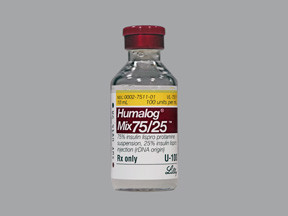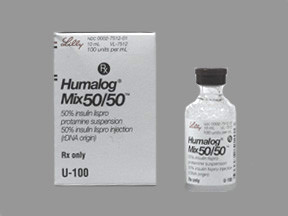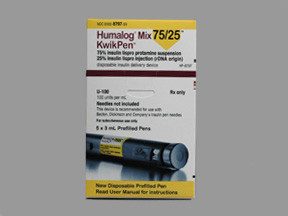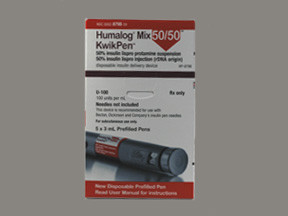INSULIN LISPRO PROTAMINE (NPL)/INSULIN LISPRO - INJECTION
PHONETIC PRONUNCIATION: (IN-sue-lin LISS-pro PRO-tah-meen(NPL)/IN-sue-lin LISS-pro)
COMMON BRAND NAME(S): Humalog Mix
GENERIC NAME(S): insulin lispro protamine and insulin lispro
Uses
USES: Insulin lispro protamine/insulin lispro is used along with a proper diet and exercise program to control high blood sugar in people with diabetes. This product is a combination of two man-made insulins: intermediate-acting insulin lispro protamine and rapid-acting insulin lispro. This combination starts working faster and lasts for a longer time than regular insulin. Insulin is a natural substance that allows the body to properly use sugar from the diet. It replaces the insulin that your body no longer produces, thereby lowering your blood sugar. Controlling high blood sugar helps prevent kidney damage, blindness, nerve problems, loss of limbs, and sexual function problems. Proper control of diabetes may also lessen your risk of a heart attack or stroke.
How to use INSULIN LISPRO PROTAMINE (NPL)/INSULIN LISPRO - INJECTION
HOW TO USE: Read the patient information leaflet provided by your pharmacist before you start using this medication and each time you get a refill. If you have any questions, consult your doctor or pharmacist. Follow all package directions for proper use/injection/storage of the particular type of device/insulin you are using. Your health care professional will teach you how to properly inject this medication. If any of the information is unclear, consult your doctor or pharmacist. Do not inject cold insulin because this can be painful. The insulin container you are currently using can be kept at room temperature (see also Storage section). Wash your hands before measuring and injecting insulin. Check the product visually for particles, thickening, or clumps before rolling and turning the container. If any are present, discard that container. To avoid damaging the insulin, do not shake the container. Gently roll and turn it between your palms at least 10 times. If using a cartridge or prefilled syringe, turn it upside down so that the glass ball moves from one end to the other. Gently mix the insulin until it appears evenly white and cloudy. If it does not appear this way, discard it. The dosage is based on your medical condition and response to treatment. Measure each dose carefully, and use exactly as prescribed by your doctor. Even small changes in the amount of insulin may have a large effect on your blood sugar. Before injecting each dose, make sure the injection site is clean and dry. Inject this medication under the skin of the abdomen, upper arms, or thighs, usually twice daily, 15 minutes or less before the morning and evening meal or as directed by your doctor. Do not inject into a vein or muscle. Eat promptly after taking this insulin to avoid low blood sugar (see also Side Effects section). Change the location of the injection site daily and do not reuse the same site for two weeks to avoid problem areas under the skin. Do not mix this product with other insulins or use it in an insulin pump. Use this medication regularly as directed by your doctor in order to get the most benefit from it. Carefully follow the insulin treatment plan, meal plan, and exercise program your doctor has recommended. Monitor your blood sugar on a regular basis. Keep track of the results, and share them with your doctor. This is very important in order to determine the correct insulin dose. If you are measuring doses from vials, do not reuse needles and syringes. If you are using the cartridges or pens, use a new needle each time. Do not share your pen device with another person, even if the needle is changed. You may give other people a serious infection, or get a serious infection from them. Learn how to store and discard medical supplies safely. Tell your doctor if your condition does not improve or if it worsens (your blood sugar is too high or too low).
Side Effects
Precautions
Interactions
Overdose
Images
Reviews
Disclaimer
IMPORTANT: HOW TO USE THIS INFORMATION: This is a summary and does NOT have all possible information about this product. This information does not assure that this product is safe, effective, or appropriate for you. This information is not individual medical advice and does not substitute for the advice of your health care professional. Always ask your health care professional for complete information about this product and your specific health needs.





No Reviews Yet